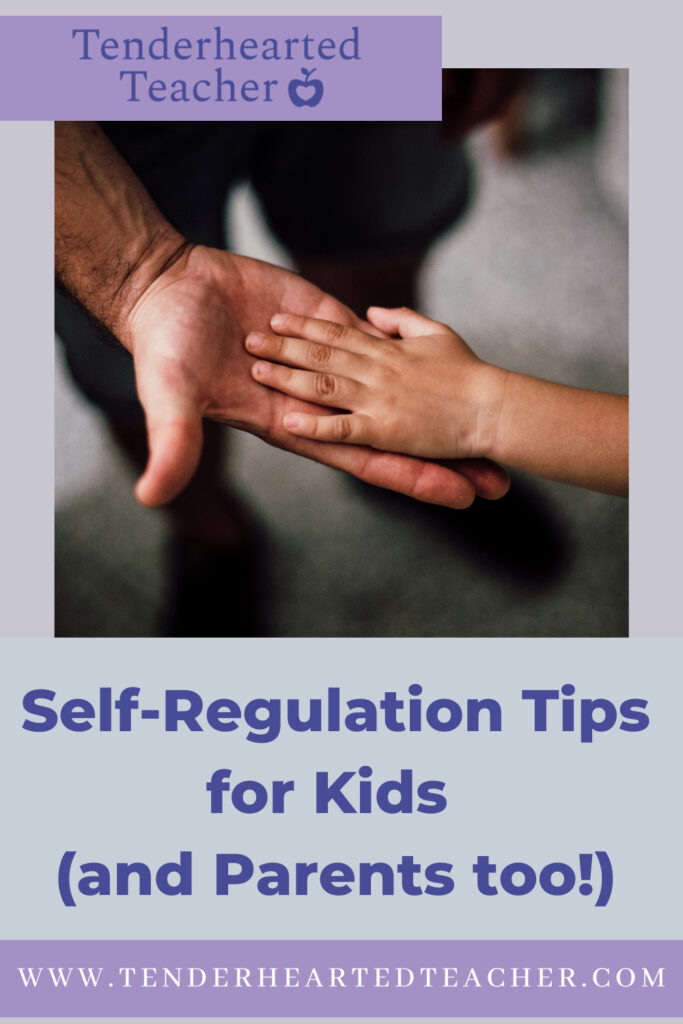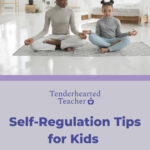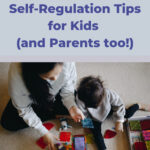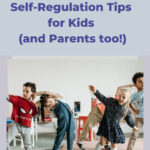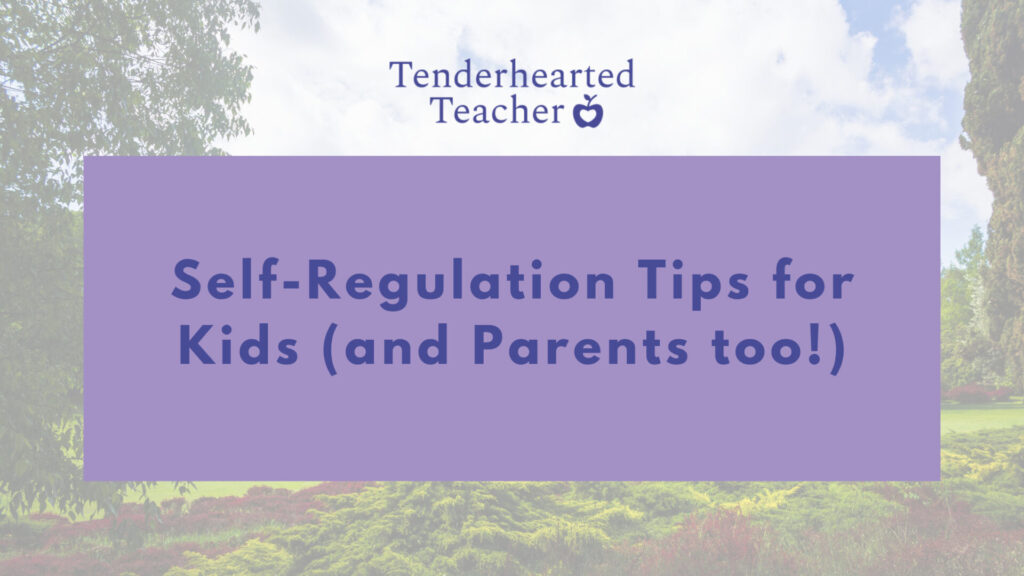
The world we live in is ripe with situations that can make us feel emotionally frazzled and physically overwhelmed. Let’s take a look at a simple example…you’re a member of the bridal party for your best friend’s wedding, but your flight gets canceled on your way to the big event. In that moment, your nerves feel shot and your mind and body start to react to this news. You might throw a fit and lash out at the airline worker. Or you might take a deep breath, hop on your smartphone, and figure out a new way to get from point A to point B. Hopefully, you pick the second option and you do this because you have the tools to regulate your emotions and nervous system–even under times of great stress. This post will discuss self-regulation tips for kids and adults, alike, as well as discuss how this process helps us stay calm and grounded in our everyday lives.
Please note: This post may contain affiliate links. As an Amazon Associate, I earn from qualifying purchases. Therefore, if you buy something through these links I will receive a small commission at no extra cost to you. Thank you for your support.
What is Self-Regulation?
Before we get into the tips and strategies, it’s important to define emotional and sensory regulation as well as regulatory dysfunction. I would define emotional regulation as the ability to not only recognize and understand one’s emotions and their causes, but also being able to manage these emotions in a healthy way, i.e. respond rather than react. Sensory regulation is closely tied to this emotional process. It allows us to refocus our nervous system to match our environment/current situation. This, in turn, allows us the opportunity to emotionally regulate using appropriate strategies. Regulatory dysfunction, on the other hand, is the inability to consistently regulate our emotions and/or use healthy strategies to cope.
I’ve spoken with Jessica Addeo, an occupational therapist and adult coach with 15+ years of experience in pediatrics, to learn more about self-regulation and how it impacts our daily lives and relationships with ourselves and others.
Addeo defines self-regulation, “as the correct amount of coping chemicals for a given situation. Meaning you have what you need in your brain and nervous system to show up grounded, centered, present and aware.” She adds, “I think a really important distinction is that regulated does not have to mean zen master calm. Some people are loud and enthusiastic in their regulated state and some people are quiet. Both are okay!” Furthermore, she states, “regulation describes your internal capacity for presence and connection (and for our kiddos, learning!) When you are regulated, your brain and nervous system are in “neutral” (the science word is homeostasis), everything is flowing smoothly and you are available for the outside world.”
Why is self-regulation important?
There was something that really struck me during my interview with Addeo. She stated that when a person feels dysregulated, their brains are “literally offline.”
She noted that regulation is born in the nervous system. “It is about the coping chemicals in your brain and system being at the correct levels for both you and your environment. This is really everything, because without this your brain will not feel safe. And this is your brain’s main job, to make sure you are safe. So it will continue to keep you on high alert (think anxiety, distraction, perseveration) until it feels safe again.”
She adds, “In order to free your brain up to engage, learn, socialize, etc., you need to have some semblance of regulation inside. Otherwise, your brain is preoccupied with creating that safe feeling, leaving you unavailable for anything else.”
This dysregulation can negatively impact a person’s ability to function in their daily lives. For example, adults may struggle with their jobs and relationships and children may struggle in school and, even more significantly, with their ability to learn and take in new information.
Self-regulation vs. Co-regulation
So how does a person learn to regulate? Before a child learns to self-regulate, they must experience and learn through co-regulation. This is done with guidance from adults and caregivers. In fact, the National Institute for Children’s Health Quality states “When babies grow up with co-regulation during moments of stress, such as when they are struggling with strong feelings, they begin to internalize and conceptualize strategies for self-regulation and self-soothing—in their brains and in their minds.”
Addeo also notes that parents and teachers can use simple co-regulation strategies to help a dysregulated child. For example, “when we can get down on one knee (at their eye level) and use a calming voice we are providing their nervous system a guide for how to get back to being regulated.”
She also stresses the importance of self-regulation for adults before assisting children. “You can’t co-regulate anyone else from a dysregulated state yourself!”
A perfect example of this is when a parent is dealing with a child who is exhibiting a challenging behavior like a tantrum. Most people would agree that this situation will escalate if the parent loses their cool too. So, it’s extremely important for the adult to pause in these moments to recenter themselves before tending to the child.
Self-Regulation Tips for Kids & Adults
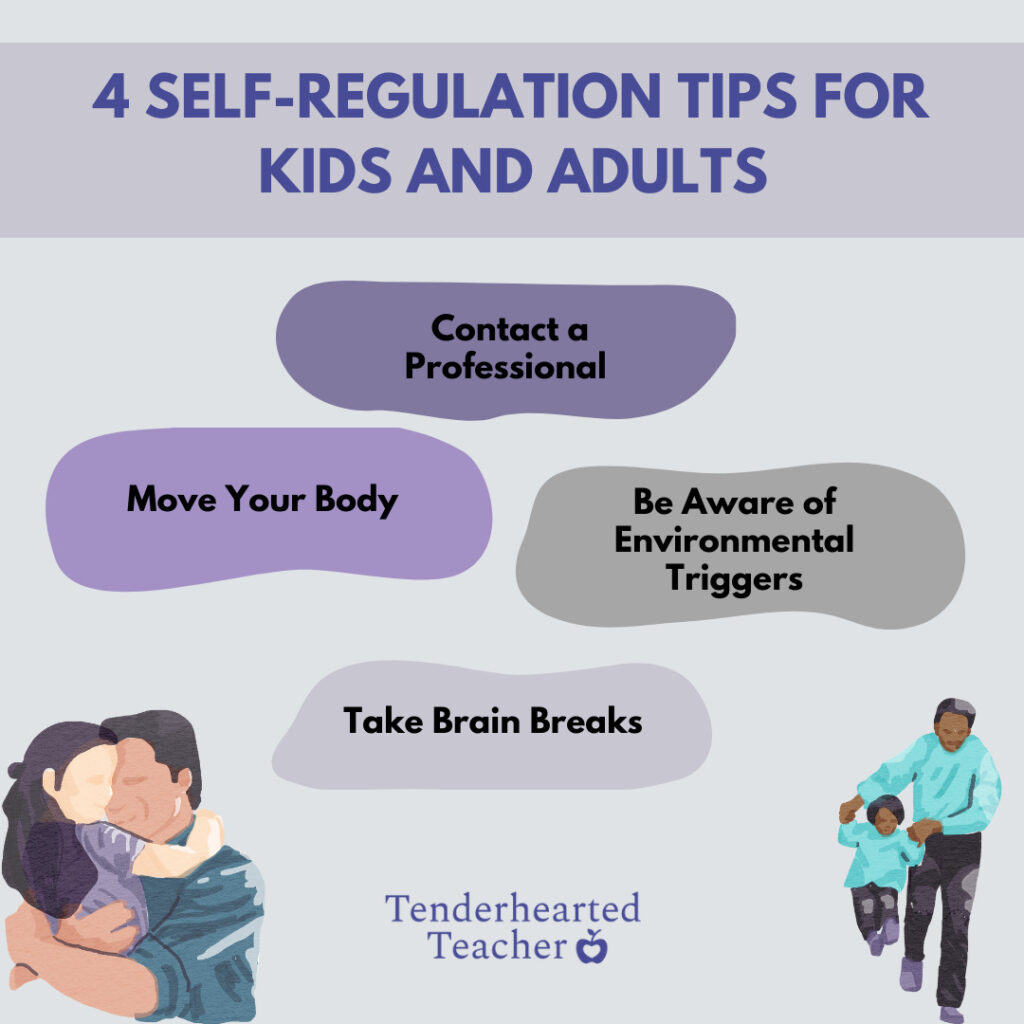
Addeo notes that we can self-regulate our nervous system with the actions we take, the way we dress, what we eat, how we move our bodies, our sleep patterns, and even our environment. She states, “while some things are out of our control, we can tweak others in our daily habits to support a more regulated, internal state.” Here are some of her emotional regulation tips for children and adults alike:
1. Contact a Professional
It is highly recommended to reach out to a licensed professional if you or your child are experiencing consistent regulatory dysfunction or if you’d just like to become more in tune with how to better help yourself. An occupational therapist or sensory coach can help you determine your nervous system settings and preferences and provide personalized strategies to assist you when you are in a heightened state.
2. Move Your Body
When you move your body you provide yourself with a particular type of sensory input called proprioception. This input releases serotonin into your body which helps you feel good! Movement for adults can include a full workout or even just a quick walk. Similarly, children respond well to movement and “heavy work.” This can include animal walks, wall push-ups, pushing a shopping cart with weighted objects inside or carrying a weighted backpack, a deep pressure massage, and/or a visit to the playground.
3. Be Mindful of Environmental Triggers
An individual may have to adjust the environment around them if they find it is causing dysregulation. For example, this can mean turning down lights that are too bright or lowering the volume on a tv or radio that is too loud. It can also mean excusing yourself from some spaces that are overstimulating.
4. Give Yourself a Brain Break
This is a moment in time when your brain doesn’t have to process new information and can renew its coping chemicals. “As adults, in our society, we are so used to just pushing ourselves to keep going and working on overdrive. But this is not sustainable and feels pretty yucky. So, it’s important to retrain our brains to take breaks,” she says. Addeo also notes she often drives home from work in a quiet car– no phone calls, no radio, no podcasts– because it gives her brain a much-needed break to reset between her workplace and home life.
Brain breaks for kids can include jumping, resting, dancing, stretching, mindfulness and breathing activities, etc. Here are a few of my favorite brain break videos for kids:
Additional Self-Regulation Tips & Resources for Kids
As previously mentioned, the ability to self-regulate is closely tied to our emotional responses. Therefore, I’d like to share some of my previous posts that dive a bit deeper into social-emotional learning and how to encourage your child’s emotional intelligence at home.
- How to Encourage Social-Emotional Learning in Preschoolers
- Yoga for Preschoolers: Why it’s Great for Little Ones
Additionally, visit my Etsy shop for games and activities that teach important social-emotional vocabulary and skills.

Finally, check out my workbook, Mindful & Wonderful Me: A Wellness Activity Book for Kids, which promotes your child’s mind, body, and emotional awareness with simple exercises and activities.
Conclusion
Parents and caregivers play a vital role in helping children learn to regulate their emotions and nervous systems. They do this through co-regulation, modeling healthy strategies, and creating a supportive environment for their children to express their emotions. Self-regulation not only helps children to navigate difficult and stressful situations during childhood, but it also helps them to develop long-term coping strategies that will follow them into adulthood.
Now talk to me! What are your favorite self-regulation tips for kids and/or adults? Share your suggestions in the comments below.
About Our Source
Jessica Addeo, occupational therapist and adult coach. After 15+ years working in pediatrics, she realized just how much the parents and adults in a child’s world are imperative to their success. The adults need to be regulated and supported in order to truly provide that for children. In addition to her pediatric practice, Addeo offers online live coaching for adults to learn about their nervous systems and regulation. Find her on instagram (@jessicaraddeo) to learn more about how to find internal calm amongst the chaos in a real way.
SAVE TO PINTEREST
